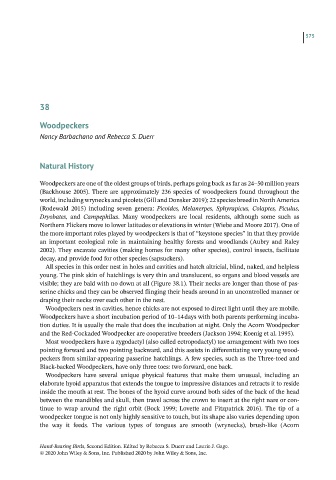Page 574 - Hand rearing birds second
P. 574
575
38
Woodpeckers
Nancy Barbachano and Rebecca S. Duerr
Natural History
Woodpeckers are one of the oldest groups of birds, perhaps going back as far as 24–50 million years
(Backhouse 2005). There are approximately 236 species of woodpeckers found throughout the
world, including wrynecks and picolets (Gill and Donsker 2019); 22 species breed in North America
(Rodewald 2015) including seven genera: Picoides, Melanerpes, Sphyrapicus, Colaptes, Piculus,
Dryobates, and Campephilus. Many woodpeckers are local residents, although some such as
Northern Flickers move to lower latitudes or elevations in winter (Wiebe and Moore 2017). One of
the more important roles played by woodpeckers is that of “keystone species” in that they provide
an important ecological role in maintaining healthy forests and woodlands (Aubry and Raley
2002). They excavate cavities (making homes for many other species), control insects, facilitate
decay, and provide food for other species (sapsuckers).
All species in this order nest in holes and cavities and hatch altricial, blind, naked, and helpless
young. The pink skin of hatchlings is very thin and translucent, so organs and blood vessels are
visible; they are bald with no down at all (Figure 38.1). Their necks are longer than those of pas-
serine chicks and they can be observed flinging their heads around in an uncontrolled manner or
draping their necks over each other in the nest.
Woodpeckers nest in cavities, hence chicks are not exposed to direct light until they are mobile.
Woodpeckers have a short incubation period of 10–14 days with both parents performing incuba-
tion duties. It is usually the male that does the incubation at night. Only the Acorn Woodpecker
and the Red‐Cockaded Woodpecker are cooperative breeders (Jackson 1994; Koenig et al. 1995).
Most woodpeckers have a zygodactyl (also called ectropodactyl) toe arrangement with two toes
pointing forward and two pointing backward, and this assists in differentiating very young wood-
peckers from similar‐appearing passerine hatchlings. A few species, such as the Three‐toed and
Black‐backed Woodpeckers, have only three toes: two forward, one back.
Woodpeckers have several unique physical features that make them unusual, including an
elaborate hyoid apparatus that extends the tongue to impressive distances and retracts it to reside
inside the mouth at rest. The bones of the hyoid curve around both sides of the back of the head
between the mandibles and skull, then travel across the crown to insert at the right nare or con-
tinue to wrap around the right orbit (Bock 1999; Lovette and Fitzpatrick 2016). The tip of a
woodpecker tongue is not only highly sensitive to touch, but its shape also varies depending upon
the way it feeds. The various types of tongues are smooth (wrynecks), brush‐like (Acorn
Hand-Rearing Birds, Second Edition. Edited by Rebecca S. Duerr and Laurie J. Gage.
© 2020 John Wiley & Sons, Inc. Published 2020 by John Wiley & Sons, Inc.

